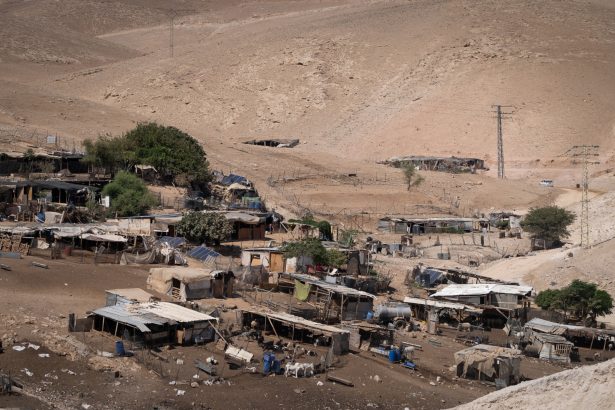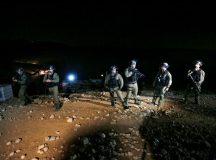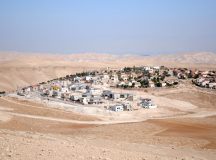Hagit Ofran is co-director of Settlement Watch, a project of the Israeli peace movement, Peace Now. In this article she analyses recently obtained data on the allocation of ‘state lands’ in the West Bank since 1967 and examines the validity of the concept as the controversial demolition of Khan al-Ahmar looms. Download the full PDF here. For a contrasting analysis read Naomi Kahn here.
Introduction
New information obtained by Peace Now reveals that since 1967, 99.8 per cent of the ‘state land’ Israel allocated in the West Bank was for the needs of Israeli settlers, while the Palestinians, who constitute 87 per cent of the West Bank population, were allocated at most only 0.24 per cent (about 1,625 dunams). Moreover, most of the state land that was allocated to the Palestinians was compensation for intended settlement development.
These figures bring the settlement dispute back to the central question facing Israel: the moral validity of its control over the Occupied Territories and its Palestinian residents for decades without full rights. With such data it is very difficult to argue that Israel rules these territories fairly and honestly for the benefit of the Palestinian residents, as required by international law and moral norms.
In recent weeks the case of the demolition of the Bedouin community of Khan al-Ahmar has raised serious questions about Israeli policy in the Occupied Territories and the concept of ‘state lands’. These Bedouin from the Jahalin tribe were expelled from the State of Israel in the early 1950s and migrated to the Judean Desert area of the West Bank. In the 1970s, there was already a Bedouin community in Khan al-Ahmar, whose residents were given permission from Palestinian land owners in Abu Dis to settle on their land. The Israeli authorities did not grant them building permits for the tents and huts they use, and they live in the area without connection to infrastructure. In the 1980s, Israel declared the land to be ‘state land’—a misleading term for ‘public land’ since it is not part of the State of Israel—and the residents of Khan al-Ahmar became trespassers on this ‘state land’, according to the Israeli authorities.
Many times in my lectures to Israeli youth I ask if they can explain what the Israeli interest is in the demolition and expulsion of a small poor community living in the desert. As Israelis, we hardly think about it; we are in charge of law and order in the West Bank, and those Bedouin don’t have permits, so we enforce the law; little do we think about the laws themselves, how they are enacted, and for what purpose.
The data mentioned above about the state’s systematic denial of allocating any land for Palestinian use exposes a policy of structural and systemic discrimination, which is precisely what is preventing the Bedouin villagers of Khan al-Ahmar from obtaining even minimal parcels of land to sustain their community. It is another sad proof that Israel’s continued control of the territories and denial of rights to Palestinians while maintaining hundreds of settlements has no moral basis.
Who is allocated ‘state land’ in the territories?
Following a request under the Freedom of Information Act submitted by Peace Now and the Movement for Freedom of Information, and after having refused to give over the information for two and a half years, the Civil Administration’s response was received and revealed that:
- 76 per cent (about 674,459 dunams) of state land allocated for any use in the Occupied Territories was allocated for the needs of Israeli settlements. The Palestinians were allocated, at most, only 0.24 percent (about 1,625 dunams).
- Approximately 80 per cent of the allocations to Palestinians (1,299 dunams) were compensation for establishing settlements (669 dunams) and for the forced relocation of Bedouins (630 dunams), so that the Palestinians were allocated at most 326 dunams, of which at least 121 are currently in Area B under Palestinian control.
(For a full list of land allocations to the Palestinians, see here. )
‘State lands’ – but of which state?
The term ‘state lands’ is misleading. In the Occupied Territories there is no ‘state’, neither the State of Israel nor the State of Palestine. It is an area that is held by military force by the State of Israel. The more appropriate term is ‘public lands’, lands belonging to the public and managed by those who assume sovereignty.
In 1967, the State of Israel assumed responsibility for the West Bank, including the management of public resources, and was supposed to manage them for the benefit of the occupied population. Until the Interim Agreement in 1995 (Oslo II), the Israel Defense Forces (IDF) was directly responsible for all Palestinians living in the West Bank and the Gaza Strip, including the conduct of daily life in all towns and villages, as well as education, welfare, development and security. The Oslo Accords established the Palestinian Authority, which assumed responsibility for certain civil matters in about 40 per cent of the West Bank (Areas A and B), while the IDF continued to directly manage Area C (60 per cent of the West Bank).
During the first 28 years of Israel’s occupation, until 1995, Israel allocated only 866 dunams of land—a precious resource—to the needs of Palestinians. Of that amount, at least 669 dunams were given to Palestinian farmers as compensation for their lands that were taken from them for the purpose of establishing settlements in the Jordan Valley.
The Israeli bluff of ‘state lands’
When talking about public lands in the territories, it is necessary to remember the manner in which they were created. The settlement project that Israel began in 1967 required a lot of legal acrobatics and a complex interpretation of the international laws of occupation. Since international law prohibits the expropriation of private lands of the protected population for the needs of the occupying power, the legal advisers of the Israeli system have developed a method whereby it is possible to ‘produce’ public lands without expropriation. They succeeded in interpreting the existing law in the territories as if there were already a great many ‘state lands,’ and all that was required was to declare their existence.
The Ottoman Land Code, enacted in 1858, stipulated that land that is not cultivated for several years becomes the land of the Sultan. On the basis of a draconian interpretation of this law, the Israeli authorities began to survey the West Bank to look for uncultivated or poorly cultivated land and to declare it as ‘state land.’ Employing this method, nearly one-sixth of the West Bank was declared as state land. The Palestinian landowners, whose lands were listed in the property tax records, were surprised to discover one day that under Israeli rule, their land was no longer theirs because it was not cultivated, or not cultivated enough.
It is important to emphasize that none of the previous authorities in the West Bank, neither Ottoman, nor British, nor Jordanian, interpreted this section of the 1858 Land Code to such an extent. None of the previous authorities actively engaged in the search for ‘state land’ in a wholesale manner, and they did not demand an intensive cultivation standard for Palestinian villagers’ lands to count it as cultivated.
Israel’s management of ‘state lands’
In 2013, the Civil Administration gave Bimkom and the Association for Civil Rights in Israel information on state land allocated to Palestinians after a petition filed under the Freedom of Information Act. The information provided at the time revealed that the total amount of state land allocated to the Palestinians was 8,649 dunams, about 1.27 per cent of the total state land allocated.
Peace Now asked the Civil Administration for details on the purpose of these allocations, and in the Civil Administration’s response (received two and a half years later) it turned out that the figures given to Bimkom and ACRI in court proceedings were misleading, and in fact only 1,625 dunams were allocated to the Palestinians rather than 8,649.
The difference between the data (about 7,000 dunams!) stems from the fact that the state included the information provided to Bimkom and ACRI also about 7,000 dunams of private land of Palestinians considered absentees that Israel allocated to Palestinians as compensation for their private land on which Israel built settlements in the Jordan Valley. This method was later defined as illegal by the Civil Administration’s legal advisor (as appears in State Comptroller Report 56A, 2003, p. 194).
In the course of the hearings in the petition, the bodies that are supposed to manage the public lands in the territories did not have clear answers to how much land was allocated and to what purposes. This is no accident. The Civil Administration administers the land in the territories without transparency, and through the use of a subcontractor—the Settlement Division of the World Zionist Organization. Most of the state lands allocated to the settlements were allocated through the Settlement Division—a non-governmental body—enabling the settlement enterprise to operate without transparency or criticism. The government is currently seeking to continue to manage the land in the dark, and is even trying to anchor it in legislation.
However, the partial and inaccurate data we received together with information we gathered throughout the years, illustrates the following picture of the way Israel is managing lands in the West Bank:
- State lands registered by the British and the Jordanians prior to 1967 — Approximately 635,000 dunams, of which about 557,000 dunams are in Area C.
- State lands declared by Israel — Approximately 930,000 dunams, of which about 800,000 dunams are located in Area C. Until 1992, about 908,000 dunams were declared as state lands (according to State Comptroller Report 56A of 2003.) In 1992 the Rabin government stopped the declarations, but the Netanyahu government renewed them in 1998. Since 1998, 22,515 dunams have been declared state lands.
- State lands expropriated by Israel via an expropriation order (mainly for roads) — Approximately 77,000 dunams.
- State lands allocated for any use — 676,084 dunams (about 50 per cent of state land).
- State land allocated to Israelis — 674,459 dunams (about 50 per cent of state land).
The uses for which the lands were allocated:
- The Settlement Division — about 400,000 dunams.
- Local authorities, public buildings, cellular companies, etc. — approximately 103,000 dunams.
- Government ministries and public companies (such as electricity, water, communications) — some 160,000 dunams.
- Private companies owned by Israelis — about 11,459 dunams.
- State lands allocated to Palestinians — about 1,625 dunams, or 12 per cent of the state land, and approximately 0.24 per cent of the allocated state land.
The uses for which the lands were allocated to the Palestinians:
- Public buildings, sports, infrastructure — 94.3 dunams
- Industry — 117 dunams
- Agriculture — 732.8 dunams, of which at least 669 dunams were compensation for land taken for the establishment of settlements.
- Forced transfer of Bedouin — 630 dunams. (270 dunams for the A-Rashidiya tribe near Jericho and 360 dunams for the Jahalin tribe near the garbage dump in Abu Dis — most of the allocations have yet to be implemented.)
- Unknown use — 50.5 dunams (probably agriculture).
The changing Israeli discourse
About 12 years ago, I was privileged to work with my predecessor Dror Etkes on research that changed everything we knew about the settlements. The report, One offense begets another (2006), revealed that about one-third of the area of the settlements is privately owned by Palestinians. I always knew that the settlements were unfairly taking lands that should belong to the Palestinian nation, and that this was illegal under international law. But I never thought that we would steal the private property of the Palestinians.
The information in the report did not cause an earthquake in the Israeli public at the time, but it served as a basis for moves that dramatically changed the public discourse on the settlements. At last we could now know whether any particular house built in the settlements was on private land or not. Peace Now and other organisations were thus able to file petitions to the High Court of Justice against settlement construction on private Palestinian property—illegal even according to Israeli law.
These petitions caused a political storm and led the court to compel the Netanyahu government to evacuate several settlement areas, including Migron (2012), Ulpana (2012), Amona (2017) and more. Another significant achievement of these petitions was that since then, almost no new settlements were built on private Palestinian land.
But then came a change in the public discourse. Often when I approached a journalist with a story about the establishment of a new outpost or neighborhood, they would ask me: Is this private land? If not, then ‘there is no story.’ What the journalist meant was that if it was considered legal according to Israeli law, despite being an important development with severe political implications, it wasn’t newsworthy. The critical political question for Israel’s future that the construction in settlements pose, of the possibility of — and the price to realise — a two-state solution, became less interesting. It turned out that as we directed our attention to the illegality of some construction, we removed the focus from the construction that was considered ‘legal’ according to Israeli rules.
The new data we have recently received on the distribution of ‘state lands’ in the West Bank can perhaps bring us back to the heart of the debate over the legitimacy of all of the settlements, and remind us that even when land is not considered by Israel as private land, Israel’s policy in the Occupied Territories is one based on discrimination, and is therefore immoral and illegal under international law.




































